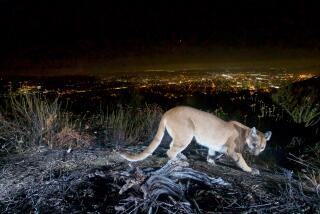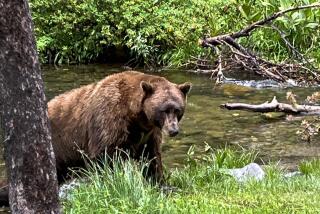Parking the Fears
CASPERS WILDERNESS PARK — Like other hikers here Friday, Pam Unsworth had heard about the recent scary cougar sighting and wanted to know from the park ranger’s own lips the answer to her question: “Is it safe?”
“Well, it is for this particular [mountain lion] because it has been caught and killed,” replied Senior Park Ranger John Gannaway, not exactly putting Unsworth’s mind at ease.
Unsworth looked him in the eye and pressed her inquiry: “Well, would you walk on the trail?”
“Yes, and I already did,” Gannaway said, adding that he has hiked and cycled safely within the 7,600-acre park ever since last Sunday’s incident, when state wardens tracked and shot a mountain lion after it charged a group of two women and three children.
Subsequently, park rangers have posted more signs warning visitors of the threat of mountain lions. And the debate over park safety may move back to the county Board of Supervisors.
Two of the five supervisors said Friday that they favor reversing the board’s 3-2 vote last month to reopen the park to unlimited use by children and will seek a study of lions in the park. The issue could be discussed at the Jan. 13 board meeting.
But other supervisors stand by their decision to lift the prohibition on children using Caspers, where there have been problems before.
“Caspers is no more dangerous than the other wilderness parks,” said Supervisor Thomas W. Wilson, whose district includes the park. “We’ve had two incidents in [Whiting/Limestone Wilderness Park] recently and nobody called for closing that park.”
Wilson and Supervisor William G. Steiner said they will not change their votes to remove the ban.
Supervisors Todd Spitzer and Charles V. Smith said they support asking the board to vote again on the ban. Supervisor Jim Silva, who voted with the majority to erase the ban, could not be reached for comment Friday. Spitzer hopes the latest cougar episode at Caspers might sway Silva’s vote.
The park was closed to minors in 1992 after the family of a girl severely mauled there in 1986 won a suit against the county. The award of $2.1 million for the mountain lion attack on Laura Small, who was 5 at the time, was later reduced to $1.5 million.
In 1995, children were allowed back into the park with some restrictions. Those under 18 were permitted only in the campgrounds and day use areas. They were not allowed on the trails without adult supervision.
*
Gannaway and state Fish and Game officials said the decision to kill the female mountain lion last Sunday was prompted by extremely unusual and aggressive behavior by the animal.
Despite yelling and shouting by the two adult women, the lion remained in a crouched position after charging to within three feet of the group, according to Gannaway.
The cougar bared its teeth and hissed before one of the women threw a child’s hiking boot at it, causing it to retreat, he said.
When a second sighting was reported an hour later, rangers notified state Fish and Game officials. They called in wardens who tracked and killed the lion.
The carcass has been taken to a veterinary’s laboratory in San Bernardino. The results of a necropsy are pending, said Pat Moore, a Fish and Game spokesman in Long Beach.
Douglas Updike, the state’s large mammal program coordinator in Sacramento, said the mountain lion population at Caspers and the surrounding wilderness areas is estimated at four to five lions for every 100 square miles.
He reported at least 4,000 to 6,000 adult mountain lions in the state.
“They have a preference for deer,” Updike said, “but certainly will switch when deer numbers get low to big horned sheep, and also livestock such as sheep, goats and cattle. And also pets that find their way out there too can be targets.”
Ray Davis, who got up early Friday and left his Garden Grove home to hike at Caspers, said that he walks alone and understands the dangers of a wilderness area.
“I usually carry a knife for protection and I don’t like to hike at sunset, because if it gets dark here, you can’t see where you’re going,” Davis said. “But I was sorry to hear that they killed that lion though.”
*
By nature, mountain lions are secretive and not an easy animal to see, said Sonke Mastrup, a state wildlife biologist.
“Luckily, they apparently don’t really like humans and avoid people,” Mastrup said. “But on occasion they can get desperate, especially if the animal is sick or they’re not able to hunt normally.”
Since the latest incident, precautions have included posting additional warning signs at the park’s entrance and in bathrooms.
Also, rangers handed out a flier to each visitor with a warning to “be cautious.”
“They have been known to attack without warning,” the flier stated. “Your safety cannot be guaranteed.”
More to Read
Sign up for Essential California
The most important California stories and recommendations in your inbox every morning.
You may occasionally receive promotional content from the Los Angeles Times.









